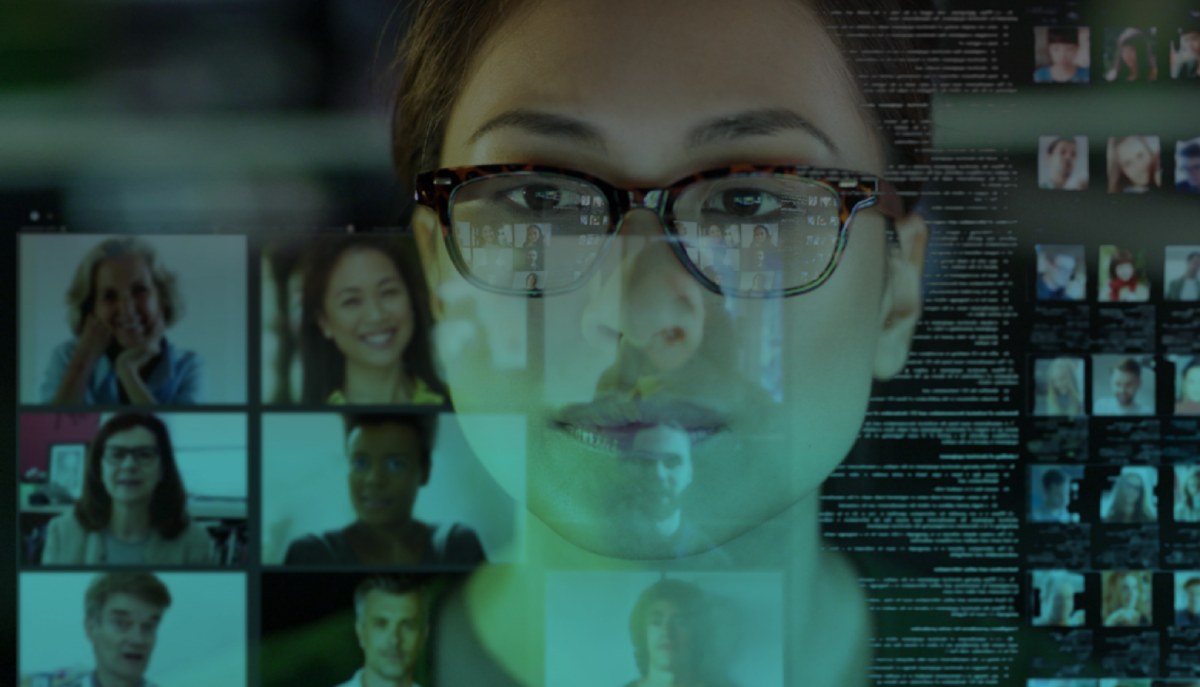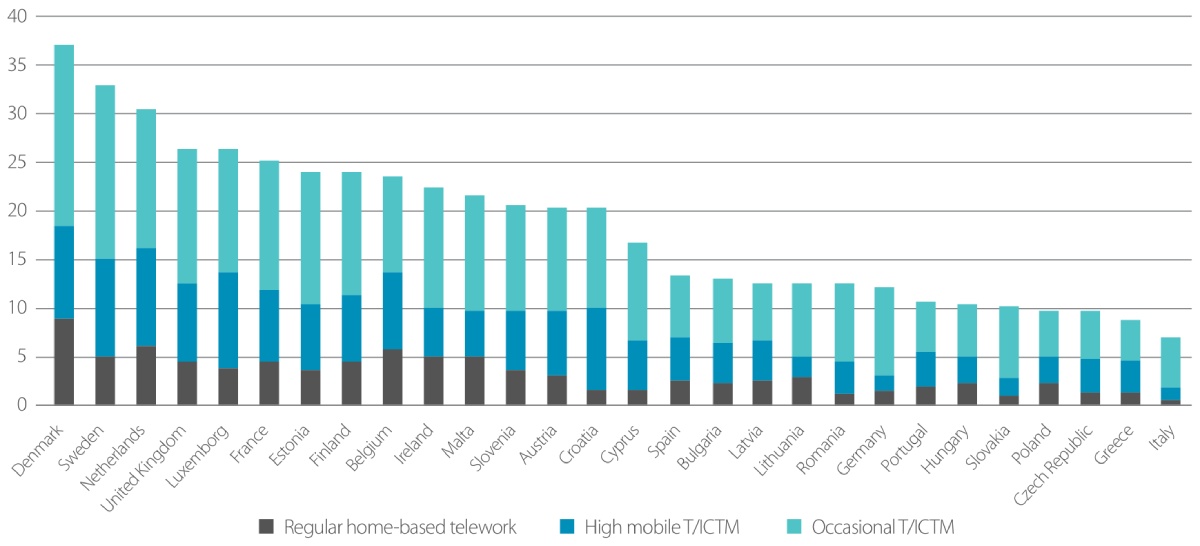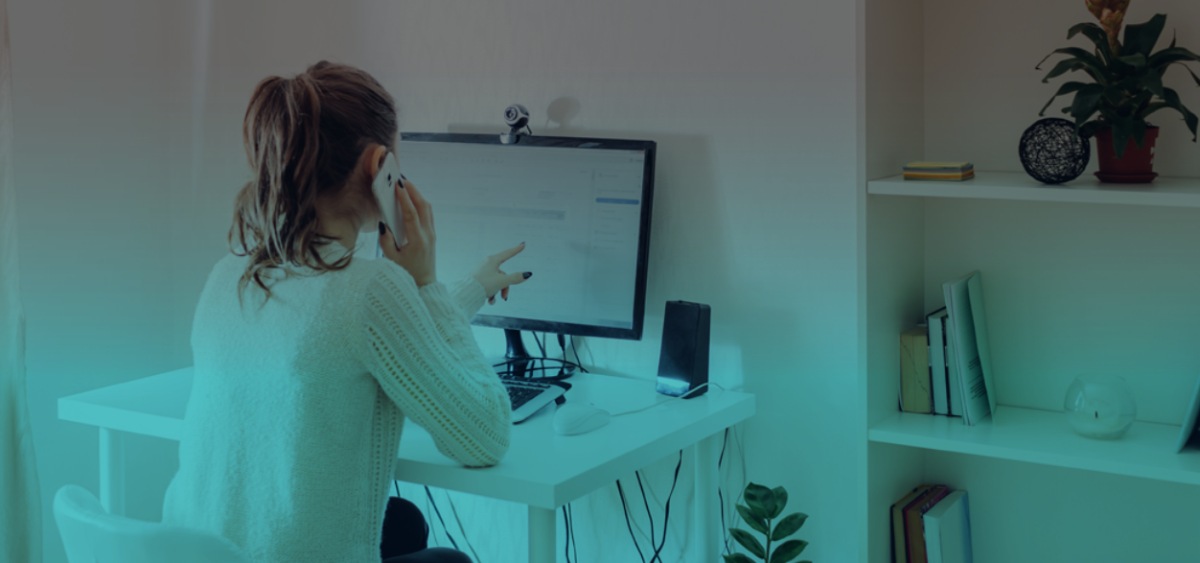WHAT ARE THE BENEFITS AND CHALLENGES OF REMOTE WORKING FOR GLOBAL BUSINESSES?
Contents
Executive Summary
Introduction
Prior to March 2020 remote working was thought to enhance work-life balance.
Since then, we have been immersed in remote working and now understand many of the challenges and issues that it brings about. As we come out of the pandemic, most organizations are planning on keeping those changes, or at least adopting new working practices.
Remote working can help employees spend their time more intelligently, giving greater flexibility over how and where they work, which, when managed correctly, can be a benefit to all – think of all those parents stressing out over school pick-up times, for example.
But concerns around loneliness, loss of culture, lack of, or poor quality of social interactions, and lacking those moments of serendipity, which is widely recognized as a benefit of the office, make it a headache for organizations.
Looking back over this period, we can assess the pros and cons of remote working so that, looking forward, we can learn from our mistakes and create a workplace that works for all.
The purpose of this paper is to outline what organizations now need to consider so that their employees are able to work remotely in a safe manner, especially as you may be moving away from the traditional 'office' as the primary workspace.
Methods
A search of the literature between 1974 and 2020 was undertaken and included the grey literature from the International Labour Organisation (ILO), Eurofound, OSHA, OSHA EU (Europe), Australia, Canada, UK, USA, Medical Research Journals and professional bodies.

Background Information
Remote working appears a mystery open to interpretation and it is important that we first define what is remote working.
Remote working embodies at least 18 terms which covers working outside of the main organization building using information and communication technologies (ICT). Telework appears to be the preferred academic term for remote working, while home working is a common term applied by governments during the current COVID-19 pandemic. Organizations use a range of terminologies and these are explored within this paper.
Who is Classified as a Remote Worker?
Having researched reports into labor trends (such as Eurofound European Working Condition Survey 2019) from around the world there is no clear definition. The ILO in their 'Issues Paper for the Global Dialogue Forum on the Challenges and Opportunities of Teleworking for Workers and Employers in the ICTS and Financial Services Sectors (Geneva, 24–26 October 2016)' identifies that a remote worker should be defined by the time spent working away from the main organizational building rather than the type of role.
Remote working can be identified as 'work, which could also be performed at the employer's premises, is carried out away from those premises using ICT on a regular basis'.
Remote working appears to be seen within many organizations as a 'perk' of certain roles and as such is not appropriately managed. This may appear controversial; but research identifies that around 90% of remote working is undertaken without formal contractual arrangement, is not properly risk assessed and little or no support program provided to the remote worker.
The reason for the above appears to be related to the lack of regulation and what regulation covers remote working.
The US has the Teleworking Enhancement Act but only supports Federal Government employees.
The EU has developed EU Directive 91/533/EEC 'on an employer's obligation to inform employees of the conditions applicable to the contract or employment relationship'.
While this defines the contractual obligations of the employer it does not set any health and safety standard. The expectation is that employers will recognize their duty of care to reduce the risk of ill-health.
It is widely recognized, both in regulation and reporting, that the risk of ill-health to those remote working includes both physiological and psychological risks.
Risks to Health and Mental Health from Remote Working
The increase in remote working in 2020 has confirmed that this is the case with qualitative evidence now emerging relating to:
![]() Increases in weight
Increases in weight
![]() Greater prevalence of musculoskeletal disorders in from what is often termed a sedentary population
Greater prevalence of musculoskeletal disorders in from what is often termed a sedentary population
![]() Significant increases in psychological problems.
Significant increases in psychological problems.
The musculoskeletal problems arise from even less movement for many people with the removal of a need to travel and walk around the office.
This combined with the temptation to eat more at home is leading to excess weight. The psychological aspects are arising from:
![]() The lack of social contact
The lack of social contact
![]() The frustrations of technology-related issues
The frustrations of technology-related issues
![]() The quality of a home work-station and working environment
The quality of a home work-station and working environment
![]() Lower levels of supervision and management
Lower levels of supervision and management
![]() Increased risks of human error including data protection breaches
Increased risks of human error including data protection breaches
With this in mind, organizations should identify the risks of remote working and help employees self-assess their own workstations. Any physical or psychological risks identified as part of this process can then be further evaluated and appropriate action taken.
What is worrying is that OSHA EU has identified that across the EU the completion rate for MSD risk assessments is 50%. There are no statistics available for Display Screen Equipment specifically.
The likelihood, therefore, is that a remote worker is unlikely to be asked to complete a risk assessment for the work they undertake. Therefore, the physical and psychological risk of harm is likely to increase in both incidence and severity.
This opinion is supported by qualitative data emerging from the UK during the pandemic where it appears that even larger and well-known organizations appear to be ignoring this risk, possibly because they thought the crisis would be short lived.
However, the data is clear and employers should not ignore this health issue.
UK and World Trends
Pre-COVID-19, workplace culture, seniority, gender, job role and where you live all played a big role in how remote working was approached.
High tech business appeared to embrace remote working. More traditional businesses who focus on data privacy and security are less likely to embrace homeworking.
Where you live is an important factor in the likelihood of you remote working.
The global leaders in remote working pre-COVID 19 were:
| Czech Republic | 15.2 (percentage of working population) | |
| Japan | 15.2 (includes self-employed) | |
| Denmark | 14.4 | |
| Belgium | 13.0 | |
| Latvia | 12.2 | |
| Netherlands | 12.0 | |
| Canada | 11.2 (19% including self-employed) | |
| Chile | 10.7 | |
| United Kingdom | 8.1 | |
| Austrailia | 6 (12% including self employed) |
Research identifies that you are more likely to work remotely if you are male, senior and work in a technical role.
This demographic is explored in more detail within this paper.
The benefits of remote working for the individual are well documented; the business case is less so.
The IBM White Paper 'Challenging the Modern Myths of Remote Working' identifies that remote workers are more engaged, provide greater innovation and respond well to performance management and provides evidence to support this.
It also articulates that remote working is not for every role or employee and the feedback from organizations and press during the current COVID-19 restrictions has reinforced this view.
Trends in Remote Worker Health
The lack of risk assessment appears to impact the health of remote workers. Musculoskeletal disorders in the form of back pain leads the way, with psychological issues being cited by workers as a key concern and an issue in the current COVID pandemic. There is little formal research into this and most of the reporting is in journals and the press. The key revelation is the instance of loneliness experienced by home workers.
With remote working, the traditional support programs are having to change. In the past, a manager would be able to observe whether an employee is struggling either physically or psychologically, but this becomes more difficult if the employee is not as visible.
Benefit offerings, such as EAPs, tend to address the symptoms but do not really consider the underlying issues and we would postulate that the potential physical and psychological stressors are not considered by most EAPs.
Those employers who are at the forefront of caring for employees are now starting to recognize this and are now requesting information from suppliers such as occupational health, to provide guidance on what can be offered to address these issues.
A further and associated concern is that of training.
As mentioned above the number of new issues that have arisen from such a fast transition to remote working has highlighted many issues that potentially have always existed but have not been identified.
Supporting Remote Workers
To support individuals who have or chose to work remotely, it is important to not only risk assess the physical and psychological risks, but also to ensure that the individual employee receives the appropriate information, instruction, training and supervision for this new world in which they work.

This needs to be adopted within a formal framework which employers continue to adapt and employees recognize the process for assessing the issues and where to access the most appropriate support.
Those undertaking remote working need to be signposted to where they can get help and support if they have any ill-health concerns, have IT issues, are struggling with their workstation set up, are concerned about any ICT, data security or other issues that arise.
It's important to help staff understand what is required of them and to prevent issues such as presenteeism (which is even more difficult with people working from home), loneliness from the lack of social contact, the feeling of isolation and feeling overwhelmed as work can take significantly longer for many people if they do not have the correct workstation at home.
In summary, health and safety legislation would expect employers to:
- Undertake risk assessments and to ensure that employees are clear in their role when working from home
- Enable employees to have some control over their work, especially when demands are high
- Have access to appropriate support from management and third parties, which includes training and
supervision
Unfortunately, at this time, all of these appear to be lacking with remote working.
Recommendations
When developing or introducing a remote working program, organizations should consider:
- Their duty of care to staff to ensure that any potential risks to health are risk assessed and managed appropriately
- Providing the opportunity to increase staff engagement and innovation
- Offer development opportunities
- Increasing corporate social engagement opportunity in our local communities
- Support sustainability programs
That said, organizations need to formalize their remote working programs by ensuring that the following issues
are developed:
- Remote working forms part of the employee contract of employment
- The workplace is defined so there is no ambiguity of where work takes place
-
Work equipment for home working is provided as part of the contract but is subject to a risk
assessment -
Remote working forms part of the occupational health and safety program and as a minimum is:
- Risk assessed – For both the physical and psychological home working environment and workstation together with an assessment of any individual risks
- Staff are provided with training on these risk and remote working
- Managers are training to support remote workers and to understand the risks
- A workplace occupational health and safety program is developed to support remote working covering psychological and physical risks with additional support for those who have disabilities (including neurodiverse conditions)
1. Introduction
What are the Benefits and Challenges of Remote Working for Global Businesses?
1. Introduction
- In early 2020 the COVID-19 pandemic hit us. It is evident that we are moving to a new 'normal' where organizations will be faced with the challenges of Government intervention in our daily lives as they try to stop the spread of the virus.
- For many of us this has meant moving our workplace to our home.
Background
- Governments have imposed COVID-secure guidance with social distancing restrictions. These automatically will limit the numbers of people who can attend the workplace resulting in a large proportion of people having to working away from their normal workspace often whether they wish to or not.
- The current crisis has created an economic impact which has resulted in organization's looking to protect workers' health and jobs by offering flexible work programs.
Initially employers planned for a short-term move to remote working but as the virus continued with little sign of abating some employers either had to or chosen to offload office space to reduce costs. Albeit that early indications of the extent of home working suggest that effectiveness is reduced and employers may not achieve the cost savings the envisaged. Either way this indicates that remote working is now going to continue without any assessment of the long-term risks.
Positive impact
- Remote working has had many positive effects; it has encouraged families to socialize, many people have found the time to exercise, freed up time given to commuting and shown us an alternative way of working. There have also been benefits to the environment which should continue as we all realize we do not need to travel as much.
Negative impact
- Conversely there have been many negative issues including:
- The lack of social contact and the associated support
- Frustrations with family members also working from home
- Musculoskeletal issues from poor workstation set up
- Presenteeism as work and life morph into one.
The initial enthusiasm of having time to exercise more appears to have waned as more people revert to even lower activities levels than before, while weight is increasing, which if sustained may ultimately lead to ill health problems. This may become the COVID legacy, irrespective of whether a person has contracted the virus or not.
There have been further impacts. Businesses reliant upon office workers have suffered economic decline, and by working from home in isolation we have not been able to socialize with our colleagues in the way we have been able to in the past.
In addition, employers are starting to recognize employee effectiveness when working from home can be reduced. This is associated with IT issues and workstation set up, combined with other distractions that have merged from working from home. They include the added burden of home schooling, caring and sharing a workspace, which may not be suitable.
2. What is Remote Working?
2. What is Remote Working
While the definition of remote working is 'the ability to be able to work from any suitable location using ICT' there is little consistency in terminology (ILO, OSHA, OSHA EU).
Remote working is not a new concept. The term has at least 18 variants; from agile working to teleworking. Lockdown in many countries has required us to 'work from home' to ensure that we keep people safe.
The term Teleworking was first coined in October 1973 by James Nilies. While the idea was floated in 1970s it took a further 13 years before an employer took the plunge to allow employees to work at a location other than their normal place of work. The Houston Chronical set up their first remote worker in 1986, after which it took a further 8 years before AT&T set up first its Telecommuting Day in 1994.
Remote working as the 'norm' has not been present until recently. Governments and organizations have struggled with the concept of remote working for reasons that historically have not been openly discussed owing to workplace culture and traditional management styles. The lack of research into the topic reinforces this view.
For the purpose of this report teleworking does not include, travelling assignments, work on multiple sites (including client sites) or working on remote assignments, this definition is used by Eurofound to set a common standard across the EU member states.
3. Legal Context
3. Legal Context
As a business Cardinus Risk Management advise a range of clients on their responsibilities to keep staff safe when using display screen equipment (this includes laptops, PCs, tablets and other forms of input devices). Healthcare rm advises clients on people issues and how these can affect a person's physical and psychological safety, whether working from home or at a traditional workplace.
Legislation in the USA
The USA is one of the few countries which has remote worker legislation, but this is limited to federal employees. Telework.gov states that telework is a work arrangement that allows an employee to perform work, during any part of regular, paid hours, at an approved alternative worksite (e.g., home, telework center). It is an important tool for achieving a resilient and results-oriented workforce.
At its core, telework is people doing their work at locations different from where they would normally be doing it. This makes sense when you consider that 'tele' comes from the Greek word meaning 'from a distance' – when combined with work it means 'work from a distance.'
Legislation in Europe
Having looked at how remote working is legislated in Europe, OSHA Europe defines its scope: 'a form of organizing and/or performing work, using information technology, in the context of an employment contract/relationship, where work, which could also be performed at the employer's premises, is carried out away from those premises on a regular basis'.
The European approach to teleworking is included in EU Directive 91/533/EEC 'on an employer's obligation to inform employees of the conditions applicable to the contract or employment relationship'.
Contractual Agreement
As we explore the legal obligations for remote/teleworking it becomes clear that the employer is responsible for ensuring that a key element of remote working is the contractual agreement between the employer and employee.
The contract needs to set where remote/teleworking takes place and what boundaries exist in the performance of an employee's role such as working hours and reporting expectations.

Other countries such as Russia have incorporated teleworking in its Labour Code, but we were unable to identify any further research in respect of teleworking in Russia.
Much of the recent homeworking has been driven by government regulation, or guidance due to the ongoing coronavirus. An announcement in June 2020 in the UK recommended a return to the work place providing the workplace was COVID-19 secure and provided social distancing and hygiene standards in work locations that had never been designed for that.
The introduction of a tiered lockdown system and Government advice 'to work from home if you can' meant that employers had to interpret guidance and employees were once again working from home with no risk assessment in place.
At this point the UK's HSE issued guidance for Employers that this was 'temporary' and gave advice on what organizations should do to manage their DSE risks. This advice was replicated in other countries.
The introduction of further lockdowns added to the confusion of what an employer should or should not do with a singular focus by governments on tackling the COVID pandemic and little or no focus on the other risks including musculoskeletal and mental ill health, which for some or even many, could far outweigh the likelihood and severity of Coronavirus.
The key issue is that we need to protect the vulnerable, the elderly and people with medical conditions or underlying lifestyle factors that increase both the likelihood and severity of contacting, being ill and even dying from COVID-19.
However, the risk for the remainder of the population who continue to work from home as this crisis continues and beyond is that we also need to consider the other risks that can arise and potentially be greater that the threat we currently face.
Employers therefore need to ensure that they assess the physical and psychological risks, not only relating to the current Coronavirus situation, but also the risks that may arise in the future if not considered and ensure that remote working is included in employment contracts.
Ensuring the Contract is Suitable
The first steps to remote working are to ensure that remote workers have a suitable contract that reflects the practicalities of working remotely and provides protection for the business.
The contract should be clear about the worker's primary place of work, which may well be their home address. It's crucial to make sure that remote workers understand that they have a personal obligation to carry out their duties for a certain number of hours per working day, and for taking proper rest breaks, given that the employer will be unable to physically monitor and enforce working time on a day-to-day basis.
Any contract should be supported by a clear policy document that considers the physical and psychological safety, health and wellbeing issues from both the perspective of the employer and the employee.
Another issue to consider carefully is the equipment including furniture, IT equipment and other items that a worker may be provided with, or required to use, in order to carry out their role remotely.
For example, many people are used to working with two screens which can improve effectiveness and make certain work easier. If this person then works from home with say a laptop, inefficiencies and frustrations are likely to arise. Working from kitchen tables and chairs can equally add to the problem.
If the business provides equipment, consideration needs to be given to who will be responsible for insuring it in case of damage, or if it is lost or stolen from the worker's home or place where they are remote working. There is a requirement to have arrangements in place for the maintenance of any business property and for its recovery if a worker leaves the business.
Whatever the decision on the provision and protection of property, it should be clearly documented in the worker's contract.
4. Employers Duty of Care
4. Employers duty of care
Having established a key principle that remote working can be an established part of an employee's contract you will need to understand the legal obligation you have to your employee.
The common theme for compliance with global regulation is set by the International Labour Organisation (Part of the UN) who advises governments on setting standards for regulation on health and safety topics.
The ILO's guidance recommends a legal framework based on the principle of the employer:
- Assessing the risks of ill health to employees
- Informing them of the risks and providing instruction
- Training on controlling the risks
While remote working legislation is limited to a small number of countries, the ILO mandate has largely been incorporated in local legislation.132 countries support this mandate in principle, if not in legislation.
5. How Effective is the Health and Safety Regulations?
5. How Effective is the Health and Safety Regulations?
It is worth noting that the June 2020 report 'Work-related musculoskeletal (MSDs) disorders: from research to practice. What can be learnt?' by the European Risk Observatory and supported by OSHA EU highlights that despite many different strategies, campaigns and policy initiatives over the past 30 years, prevalence rates of MSDs across the EU are not reducing.
The report identifies; 'New ways of working including technological changes in offices, manufacturing and construction can increase accessibility to work at all hours, and increase flexibility. However, research is not keeping pace with such changes and there is a lack of research in relation to the impact of new technologies.
New contractual arrangements are also being implemented in this new world of work. The impact of new, less formal (remote) working arrangements has resulted in concerns that there might be a loss of occupational safety and health (OSH) protection for individuals working in this way.'
What health and safety legislation and occupational health in general, appear to ignore is an understanding of the scale of work-relatedness. As an example, in the UK, data has been published on the Health and Safety Executive (HSE) website that refers to the scale of absence due to work-related conditions.
However, the data outlined was actually the level of absence for all conditions both work and non-work related.
The actual level of work-related ill health in the workplace is rarely assessed and where this is then the actual levels of work-related physical and psychological ill health are circa 4% of absent cases.
In relation to musculoskeletal disorders there are a number of common conditions that cause or contribute to an MSD including:
- Genetics – Some people will have a higher risk of an MSD due to their DNA
- Age – As we age our musculoskeletal system degenerates and if we do not do look after ourselves with
exercise and strength conditioning then our systems will degenerate at a faster pace - Excess weight – Places a load onto our bones, joints, ligaments and tendons, which over time will also
increase the pace of the degeneration and lead to pain and dysfunction - Sitting – This is a high-risk activity for our musculoskeletal system and we need to keep moving
- Sport/hobbies – These may increase the risk if the individual is not conditioned or fails to take the necessary post-exercise recovery
- Psychosocial factors – Where a person believes that their work/workstation cause them harm, this can act as a maintenance factor or obstacle to recovery even if the MSD is not related to work
Many western world countries continue to face the risks associated with modern society where we naturally undertake less activity yet have a greater access to food and alcohol, the combination of which is not beneficial to our musculoskeletal health.
The same can be said in respect of psychological risks. There is an increased reporting in stress, anxiety and depression and emotions such as loneliness, irritation, worry and guilt.
Health and safety legislation in the UK has suggested for some time that employers should undertake a risk assessment of psychological hazards and to improve understanding developed the Management Standards (2004).
This identified six key areas that could cause work-related stress, anxiety or depression:
- Demands
- Role
- Relationships
- Control
- Change
- Support
These were not intended to be exhaustive but provide a framework for organizations to assess work-related factors that can cause harm. However, very few employers undertake an assessment of psychological risks, possibly due to health and safety professionals feeling that this is a complex and difficult area that sits outside of their knowledge.

Vulnerabilities to ill health can include:
- Age – Under 29 years of age is the most vulnerable group
- Gender – Females appear more at risk although males are said to either under report, or that the mental ill
health manifests as a physical condition, such as low back pain and digestive disorders - Low levels of activity – This is a major factor in psychological ill health
- Excess weight – This is implicated and combined with inactivity, which is a major risk factor
- Sub-optimal nutrition – High sugar intake and a lack of appropriate nutrients can complicate mental ill health
- Negative attitudes, beliefs and fears – This can mean that a person can perceive a problem is work-related when actually it can be something totally different
Research reported by 'The psychological impact of teleworking: stress, emotions and health*' by Mann and Holdsworth 2003 highlighted that teleworkers experienced more mental ill-health than identified in office-based workers.
This can be due to a number of factors, such as:
- Having to deal with difficult customers (Demands) with no immediate social support network
(Relationships & Support) - Feeling of isolation (Role & Control)
- Lack of perceived support (Relationships & Support)
- Type of work (Role)
- Potential IT issues (Demands) and much more
This report is important in the current context as we start to return to the workplace. Organizations may be considering how to reduce organizational costs in the belief that this is what employees prefer.
The outcomes of large numbers of remote workers must be considered, and risk assessed to question if this is aiding work-life balance or delivering the opposite.
Social isolation and Loneliness
Social isolation and loneliness were most frequently associated with the feeling of negative emotions by the teleworkers. This supports the idea that emotion is significantly social (Parkinson, 1996) and that the reliance on CMC (Computer Mediated Communication) rather than FTF (face-to-face) communication may contribute to a decrease in workers' emotional wellbeing as proposed by Hobbs and Armstrong (1998).
Studies of loneliness propose that other negative emotions, such as anxiety, irritation and worry are linked to the all-pervading mood attached to loneliness (Peplau and Caldwell, 1978, in Rook, 1984). This may explain the prevalence of these negative emotions in the teleworking sample.

The findings that teleworkers experience more mental ill health than office workers may relate to the theory that social relationships reduce the likelihood of stress-related disorders (Rook, 1984).
For many workers the social interaction of the workplace is important, and this study has highlighted the psychological stress of separation from colleagues and the small talk and buzz that constitutes an office environment.
The idiom 'a problem shared is a problem halved' has been studied in care workers who care from home versus those that are care within institutions (Steppacher & Kissler, 2018) and while there did not appear a significant difference, what was identified is that more research is needed as the data is so varied and individual differences so complex.
What is evident is that teleworkers who are socially isolated from work colleagues should have social contact and that some individuals will be more vulnerable than others. This also suggests that a greater level of supervision (Support) is required for such employees.
This vulnerability should be identified by a risk assessment program. It should be note that research by OSHA EU identified that there was the lack of the completion of risk assessments by organizations.
This research estimated that the completion rate for MSD risk assessments was only around 50%. This is concerning as organizations believe that they are meeting their legal obligations while this evidence-based research indicates many are missing the mark.
6. Advantages of Remote Working
6. Advantages of Remote Working
Background
While this section addresses the advantages of remote working, we need to mindful that remote working does not suit all people and all roles.
This is supported by a 5-year study period undertaken by IBM from 2008 to 2012. It identified that around 9% of workers in US, Australia and Canada worked remotely and identified that roles were limited to technical workers and those who can easily access ICT. The report authors also identified that as technology was being developed, so the number of jobs suitable for remote working is increasing year on year.
The report authors highlighted the key advantages of remote working are:
- Employee engagement; Employees are better informed and managed
- Productivity
- Provides and encourages innovation
- And, provides a better work/life balance
More detailed data on the prevalence of remote working is identified by the European Working Conditions Survey (EWCS). This is carried out every five years by Eurofound and is reported in EWCS 2015.
Around 19% of workers in the EU have a remote working arrangement at work. Almost half of employees are occasionally mobile, while one-quarter are highly mobile employees.
Across the EU, remote working is most widespread in Scandinavia and less so in southern and eastern Europe (figure 2). The variations between countries can be explained by different factors such as the spread of information technology, geography and work culture, including managerial models.
Figure 2 – Percentage of employees doing Telework and ICT Based Mobile work in the EU28, by category and country

7. Mental Health
7. Mental Health
Cardinus Risk Management's white paper 'Mental Health and the Workplace: Understanding and Supporting Employees' was published with the objective of raising awareness of Workplace Mental Health issues.
The paper breaks this down into three key areas:
- Stress
- Mental ill-health
- Presentism
Many of the issues identified within this paper are relevant to this.
Research into remote working has identified a number of areas where mental health can be adversely affected:
- Loneliness
- Anxiety
- Depression
8. Ergonomics and Musculoskeletal Disorders
8. Ergonomics and Musculoskeletal Disorders
Research undertaken in 2020 and 2012 in Canada, the United States, and Western Europe indicates the prevalence of physical disabilities caused by musculoskeletal disorders to be an estimated 4–5% of the total adult population (Woolf A.D. and Pfleger B., Burden of Major Musculoskeletal Conditions. Bulletin of the World Health Organization, 2003. 81(9): p. 646–656. [PMC free article] [PubMed] [Google Scholar].
According to the World Health Organization (WHO) musculoskeletal conditions represent some of the most physically disabling health conditions.
Musculoskeletal disorders (MSDs) are the most common cause of chronic pain and long-term physical disability in human populations [4].
Taking the above further, the prevalence of MSDs appears to be linked to age. This was confirmed by a UK study, which identified that complaints of back pain are the most common reason why middle-aged people visit their GP, and the primary reason for sickness absence from work if measured by the number of episodes (incidence), or the second-most-common reason if measured by number of days lost.
Remote working can be responsible for encouraging a heightened sedentary lifestyle. Why is this?
Commuting can offer a route to some form of exercise each day. The journey itself can offer the chance to walk, cycle or run.
In an office you can move to see colleagues, attend meetings, access food and drink or use the welfare facilities.
The modern office environment therefore can offer some form of exercise compared to almost being non-existent at home.
A typical home commute can be a few feet. The need to move to talk to colleagues, access food or drink is minimal.
Exercise needs to be built into a day and there are a lot of factors that can interfere with your daily activity.
Therefore, we are now witnessing lower levels of activity than before.
9. Remote Working and Sustainability
9. Remote Working and Sustainability
How does remote working affect our communities?
There has been much written about this as remote working has led to businesses dependent upon commuters and nearby office workers having to adapt or close.
While there is no legal responsibility for organizations to consider the impact of not reopening offices there is a question of social responsibility.
Many organizations have signed up to acting responsibly and supporting their local communities. Therefore, business leaders should consider the impact of moving to a remote working model.
Carbon Emissions
Has your organization considered the carbon emissions that are created by homeworking?
This topic is only being addressed by research and is something organizations will need to consider if they are required to report under ESOS and SECR.
Homeworking Emissions Whitepaper issued by EcoAct is one of the first to provide guidance in this area. The biggest challenge will be gathering Scope 1 and 2 data from those who work remotely.
This is a topic which should not be ignored. Government interest in this area is increasing and the threshold of reporting (see below) may be reduced. Organizations who meet the following are required to report under ESOS and SCER:
Employs 250 or more people, or
Has an annual turnover in excess of 50 million euro (£44,845,000), and an annual balance sheet total in excess of 43 million euro (£38,566,700)
An overseas company with a UK registered establishment, which has 250 or more UK employees (paying income tax in the UK)
10. Home Working – Perception and Reality
10. Home Working – Perception and Reality.
The table below sets out what we have learnt from COVID-19 and sets out the changes in attitudes and beliefs of home working that have previously been reported:
From this table we explore the advantages and disadvantages of remote working in more detail:
| Working from Home Beliefs |
Before | Now |
|---|---|---|
| Work-life balance | Gives more time to spend with family and do what you want to do |
Work has now encroached into home life and it is difficult to separate the two |
| Activity | Would have more time to exercise | Daily activity has reduced and more difficult to get motivated to exercise |
| Weight | Would have more time to eat better | Too easy to access food and over eat |
| Physical health | Better for me as I can get up and move more |
Workstation issues and easy to succumb to moving less as sitting even more |
| Mental Health | Better for me as I will have more time and feel less stressed |
Other issues such as lack of social contact, isolation, lack of support, working inefficiencies are more difficult |
| Wellbeing | More time to spend with family | Juggling work and family in a confined space called home |
| Support groups | Societal togetherness | Not all inclusive and would be detrimental to some who maybe are not so social or may disagree with the approach |
| Time | More time to sleep and less time travelling |
Lower level of activity and can lead to boredom and doing less |
| Environment | Nature could be observed at the outset in a way not witnessed for more than 50 years |
Other factors such as face masks and increase of disposable but not necessarily biodegradable items added to issues |
| Technology | Ability to carry on and at least have some social contact, even if not face to face |
Frustrations with bandwidth, performance, security issues, etc., has led to other problems |
| Productivity | Some organizations initially reported improvements |
Other organizations have witnessed decreases in effectiveness and greater exposure to human error |
| Physical Health | A few dedicated individuals have found more time to look after themselves |
Many have reduced their levels of activity, increased weight and increased intake of carbs |
| Mental Health | Initial 'holiday' type feeling | Loneliness, feeling of isolation, feeling out of control, depression associated with ongoing restrictions and impact on society. Fear associated with Government and media positioning of the risk. |
Advantages
Improved Wellbeing
Improved wellbeing is dependent upon a number of factors; if you were a parent juggling a household with home schooling, a partner working and all the other challenges of work/home then your wellbeing was probably reduced. Lockdown provided opportunities to spend more time with your family, use the time commuting to better effect and catch up on sleep.
It is noticeable how organizations, social groups and families established support groups and the use of technology helped this.
There were great articles and heart-warming stories of groups of people singing from balconies in Italy to Captain 'Tom' Moore, a former British Army officer and centenarian, who raised money for charity in the run-up to his 100th birthday during the COVID-19 pandemic. It seems like we have all been touched by these stories and in a positive way.
Time
'Time you enjoy wasting is not wasted time' – Lockdown gave us back time. Time we would commute, overtime we didn't need to give. And time to spend with our families. Like wellbeing there is a challenge back.
We lost the time to separate work from home as for most of us the commute was a few steps. For others the schedule heaped upon us meant time became a luxury.
Environment
Lockdown appeared to allow the world to breathe; flights were cancelled, traffic was removed off the streets and for many who could exercise, this was restricted to a short area and normally close to home.
We could hear the birds singing rather than the sounds of traffic or trains or planes. Our countryside looked greener and we saw more wildlife than before.
This, with the requirement to exercise close to home, has made us explore our local area. The reduction in traffic has improved safety and has encouraged people to walk and cycle.
Technology
Technology came into its own. A range of tools, including IM (Instant Messaging) and teleconferencing tools such as MS Teams and Zoom allowed us to remain in contact with those we work with and care for. All of a sudden, the fear of seeing ourselves on screen seemed to diminish as the importance of social contact albeit at distance become important to us all. And it helped those who were at risk and self-isolating feel more connected.
Remote working required organizations to look at key aspects of managing their business and people risks. The result meant that a number of changes occurred. There was a move away from the traditional classroom-based training to online and via teleconferencing. Whilst these are not new formats it allowed organization's to keep pace with changes in advice and government guidance and legislation. It also meant that the employer's duty of care could be evidenced if needed and training linked to risk assessments.
Managing business risks meant firms provided innovation to employees or clients. Some examples included:
- COVID-Safe site visits
- Remote risk assessments and audits
- Virtual driver training
- Wearable technologies for health management, tracking and risk assessing
Legal compliance
The initial impact of the global pandemic was that most organizations reacted swiftly to GOV and WHO guidance. This meant that staff started to work remotely based on an immediate need. There was a lot of press showing the way staff responded to this by adopting either a pragmatic approach to remote working and or a more innovative approach.
Employee adjustments which had been put in place in an office environment became a casualty of the start of the pandemic and a make do and mend was often taken.
The biggest mistakes most employers made were:
- Not testing their Business Continuity Plan prior to the Lockdown in their location
- Not formally risk assessing the move to remote working.
That said the vast majority of organizations did make some very important decisions:
- Opening lines of communication to staff and keeping them informed of business decisions in respect of the pandemic
- Encouraging managers to meet regularly with staff
- Focusing on staff health and wellbeing
The one area all businesses struggled with was the idea that the pandemic was a temporary and how best to react to ensure legal compliance was maintained. The challenge facing businesses was empty offices other than key staff.
In the United Kingdom, the Health and Safety Executive was one of few regulators who reacted to the lockdown and stated that individual DSE risk assessments were not required but an organizational one was.
This did leave organizations with a headache and only undertaking critical or legally required maintenance activities.

Productivity
This is anecdotal; reports in the press reinforced that many businesses in the support and financial sectors performed better than pre-lockdown. For this report we will take this as given. The rationale is that lockdown taught us the importance of kindness and encouraged us to understand that we all faced the same challenges during lockdown.
Disadvantages
Loneliness
This paper has evidence that loneliness was a concern prior to COVID-19. Lockdowns have reconfirmed that this is an area we need to consider as part of our remote working programs and when establishing contracts.
Young professionals living in our major cities find themselves living in small apartments or environments which do not lend themselves readily to remote working.
In this context, remote working is only feasible if there is flexibility and individuals have the ability to work in alternative spaces when required such as cafes, libraries or similar spaces. These spaces not only offer a work area but provide social interaction.
Working in isolation creates anxieties and guilt triggered by loneliness. Organizations need to establish if there are issues to consider such as security of IT infrastructure, GDPR, where the person lives and their circumstances when agreeing to remote working.
Mental Health
The pandemic introduced us to an unseen enemy. Its impact can be devastating and as a result has affected many.
Physical Health
Our physical health has suffered as movement has been removed from our routine.
11. Duty of Care Vs. Government Guidance
11. Duty of Care Vs. Government Guidance
Organizations need to consider their duty of care of individuals. While the Government forced organizations, who could to operate from individuals' homes this Duty of Care has remained.
Anecdotal evidence showed that while most organizations put measures in place to support individuals working from home these were not considered as part of any business continuity plan or formally risk assessed at an organizational level.
This lack of planning did encourage creativity in establishing places to work from but also created anxiety for those who couldn't access their work or were struggling in environments where partners and others in the same space wanted to use the internet or quiet space to work.
There was a panicked response to buying equipment for staff working from home rather than taking steps to assess what was needed. And online meetings came to a point where there were too many!
Now 12 months on organizations need to reflect on their business risk management program. The legacy of the first 2 lockdowns needs to be reviewed to ensure that employers can mitigate on the risks which may have arisen. The concern is that if organizations are unable to document how they managed their risks during 2020 and 2021 the lessons learnt may be expensive and long reaching.

It is therefore imperative that employers start to review their risk assessment and legal compliance programs and get them into shape as quickly as possible. The issue here is that failure to meet legal compliance standards can lead to a triple hit to organizations:
![]() Prosecution
Prosecution
![]() Third party claims
Third party claims
![]() Reputational
Reputational
This is not a new statement. What is new is the current situation businesses find themselves in and it is very different to January 2020. Organizations need to consider this threat more seriously as its cheaper to risk assess than to pay any costs associated with the 3 issues highlighted above.
Leaders should take a moment to ensure that they understand their Duty of Care to their employees and take time to evaluate if the measures they have in place are adequate to manage or reduce the risk of ill-health to employees.
These risks are foreseeable as demonstrated in this paper and therefore, if not considered, could lead to prosecution by an enforcement agency or claims by individual employees.
12. Remote Working Beyond the Pandemic
12. Remote Working Beyond the Pandemic
We will explore what the future of remote working will be.
The View Over the Next Two Years
What are the effects of COVID-19 on the state of the workplace in 2021?
Returning to Work
Are you and your team ready? This might seem like a strange question, but many organizations will probably not return to the workplace until later in 2021 and its unlikely we will be back to some form of normal until 2022.
Organizations should focus on protecting the most vulnerable, which can be assessed via a personal risk assessment, or DNA testing for vulnerabilities in immunity.
The above timeline is based on vaccine availability for the general population and a national immunization program. Organizations should be planning a phased return to the office and looking at their future contingency planning.
Organizations should be looking forward and addressing the issue of remote working as working from home for 2 years is no longer temporary.
Organizations should be looking at the effectiveness of their health and wellbeing programs as they will no longer meet their staff needs.
Focus areas that need to be addressing are loneliness and presenteeism. Presenteeism should be considered where an employee is not fully productive at work due to a physical or mental health problems and where they attend work, rather than absence due to the fear of any consequences. This topic has been researched by Sainsbury Centre of Mental Health Research and then promoted by Cary Cooper.
Social distancing requirements will need to remain in place for some time, and this will affect the number of people attending the workplace.
Business travel will be reduced and for most air travel will be seen as an exception rather than the norm.
Long COVID
The impact of people who have contracted and suffered from COVID and their recovery time to being able to function as they were before their illness. This needs to be considered as part of a phased return to work with close monitoring to ensure that an individual is not placed under unreasonable pressure if they are struggling to return to normal levels of work activity
The View Over the Medium Term
The long-term effects from this current pandemic will be felt for a long time. This is due to a number of factors:
- Psychologically, we have all been exposed to a 'trauma', which for most people could never have been envisaged. A single incident of trauma can cause a lifetime effect but COVID-19 and the way in which it has been ongoing for so long has meant we have all been exposed to multiple traumas with no time for normalization
- Feeling totally out of control is another factor that increases our risk of anxiety and depression. Even the most robust individuals can get into trouble and ultimately become ill. The presentation of the extent of this 'trauma' has made this far worse. The only comparison that the elderly can draw is that with the 'trauma' of World War 2, and for other nations, more recent tragic wars.
- The physical deterioration caused by reductions in activity, excess weight and sub-optimal nutrition will lead to problems over time including increased musculoskeletal issues, diabetes (type 2), digestive problems, cardiac issues and potentially cancer.
Conclusions
Conclusions
This paper has set out to answer the question 'what are the benefits and challenges of remote working for global businesses?
This paper has considered the research undertaken prior to the current lockdown. This research highlighted many issues and identified that the many challenges faced by organizations and individuals are foreseeable. In particular, mental health and musculoskeletal issues.
Individual Perk vs. Organization-Wide Benefit
As remote working has been generally seen as a perk to the individual, this has not been resourced by organizations, and for many governmental requirements to work from home was the first time their Business Continuity Plans were tested, which this led to disruption.
Remote working as the 'norm' has not been present until recently. The term has at least 18 variants being used routinely; from agile working to teleworking. This inconsistency of approach across academia and business is reinforced by a lack of guidance in terminology used by key bodies such as ILO, OSHA, OSHA EU and HSE.
Governments and organizations have struggled with the concept of remote working for reasons that historically have not been openly discussed; such as workplace culture and traditional management styles.
The lack of regulation and research into the topic reinforces this view. And this is further reinforced when looking at how organizations support remote working. Research identifies that only 50% of organizations risk assess those working remotely.
Lockdown and its Impact on Our Relationship with Work
Lockdown has shown that remote working has had many positive effects. It has encouraged families to socialize, individuals have found the time to exercise, freed up time given to commuting and shown us an alternative way of working. There have been positive benefits to the environment, which should continue as we all realize we do not need to travel as much.
Conversely there have been many negative issues including the lack of social contact and the associated support, frustrations with family members also working from home, musculoskeletal issues from poor workstation set up and presenteeism as work and life morph into one.
The initial enthusiasm of having time to exercise more appears to have waned as more people revert to lower activities levels than before while weight is increasing, which if sustained may ultimately lead to long term ill health problems.
The pandemic has shone a spotlight on an unseen enemy – mental ill-health. Its impact can be devastating and as a result has affected many of us. Lockdown has reconfirmed that loneliness is an area we need to consider as it creates anxieties and feelings of guilt.

There has been increased reporting and concerns over anxiety in relation to the pandemic and our future.
It's important that organizations recognize these issues and develop their wellbeing program to provide support and signpost staff where it is needed. It is also critical that organizations take time to re-evaluate their legal compliance. This paper has evidenced that there are gaps in the way that organizations approach legal compliance.
The issue here is that failure to meet legal compliance standards can lead to a triple hit to organizations:
- Prosecution
- Third party claims
- Reputational
This is not new, but the situation businesses find themselves in is very different to January 2020 thus organizations need to consider this threat more seriously as its cheaper to risk assess than to pay any costs associated with the 3 issues highlighted above.
This paper has shown that the advantages and disadvantages of remote working are complex and can be based on many interlinking factors; space, workstation setup, access to the internet, technology, family/home circumstances, caring and schooling pressures and the environment.
Our conclusion is that remote working offers flexibility to organizations and individuals, but any remote working program needs to be carefully considered, planned and risk assessed and is not beneficial to all staff or roles.
Recommendations
When developing or introducing a remote working program, organizations should consider:
- Their duty of care to staff to ensure that any potential risks to health are risk assessed and managed appropriately
- Providing the opportunity to increase staff engagement and innovation
- Offer development opportunities
- Increasing corporate social engagement opportunity in our local communities
- Support sustainability programs
That said, organizations need to formalize their remote working programs by ensuring that the following issues are developed:
-
- Remote working forms part of the employee contract of employment
- The workplace is defined so there is no ambiguity of where work takes place
- Work equipment for home working is provided as part of the contract but is subject to a risk assessment
-
Remote working forms part of the occupational health and safety program and as a minimum is:
- Risk assessed – For both the physical and psychological home working environment and workstation, together with an assessment of any individual risks
- Staff are provided with training on these risk and remote working
- Managers are trained to support remote workers and to understand the risks
- A workplace occupational health and safety program is developed to support remote working covering psychological and physical risks with additional support for those who have disabilities (including neurodiverse conditions)



